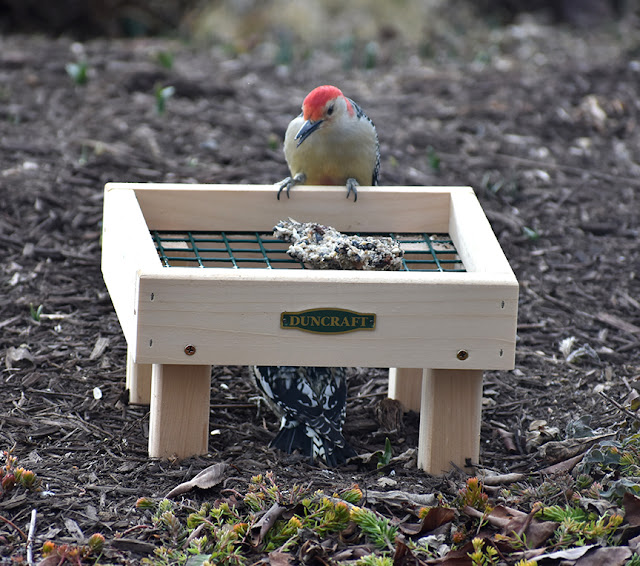 |
| Mrs. Cardinal with woodpecker and sparrow |
This pair of cardinals are shyer than the other birds--it's taken me a couple of weeks to be able to get some shots of them at the new feeder, but I finally managed it. Other birds weren't so shy, as you can see there appears to be a woodpeckers (perhaps a hairy or a downy woodpecker, or maybe two?) underneath the feeder, and a chipping or song sparrow also on the ground while Mrs. Cardinal takes her meal.
 |
| Mr. Cardinal, finally! |
Mr. Cardinal finally landed on the feeder long enough for me to take some photos, while a sparrow scarfs up what falls on the ground. He's gradually gaining confidence--this morning I found him perched on the railing of the front porch! Sadly, after only a few days of this feeding frenzy, the fruit and nut block has vanished completely. I just ordered another five blocks--I hope this will last through the beginning of March, but at this rate, who knows?
 |
| Hairy woodpecker with goldfinch an d sparrow |
Yesterday my front yard was full of birds, with one new species making an appearance--a hairy woodpecker. There may have been two of them, one I think was a juvenile, with a small red spot just above the beak, but I couldn't get a clear photo of that one. This one above is an adult.
 |
| Juvenile hairy woodpecker and cardinal |
 |
| Red-bellied woodpecker male, with hairy woodpecker under the feeder |
I wish I'd tried to take a video--the red-bellied woodpecker pair were back, perching on separate branches of the cherry tree, while one hairy woodpecker was on another branch, another small woodpecker and the white-breasted nuthatch were on the dogwood with the female cardinal, bunches of finches, dark-eyed juncos, chickadees, tufted titmice and sparrows flitted all around--on the branches, the ground, and the feeders. The male cardinal came to perch on the front doorstep a few times while this was going on. What an amazing show!
 |
| Five finches on the sock |


















